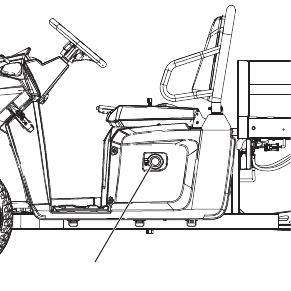
55
MAINTENANCE
Batteries
Battery Charging
When not in use, park the vehicle and connect the battery
charger. The battery charge receptacle is located on the
left side panel below the driver’s seat.
WARNING! Failure to provide adequate ventilation while
charging batteries can result in an explosion. Hydrogen gas is
emitted during charging and will rise and accumulate at the
ceiling. Always ensure a minimum of five (5) air changes per
hour in the charging area. Never charge the batteries in an area
subject to a flame or spark, including areas containing gas or
propane water heaters and furnaces. Do not smoke in the
charging area.
Always follow these precautions when charging the
batteries:
1. Position the vehicle on a level surface.
2. Make sure the charging area is well ventilated.
3. Make sure the key is off.
4. Remove any vehicle covers and open any door enclosures or zippers.
Tip: If the charger turns off due to an overheated condition (thermal cutback), remove the seat to
improve air flow. Reset the charger (interrupt AC power for 15 seconds).
5. Always use a extension cord with a minimum rating of 20 amps.
6. Inspect the charging cord and extension cord for cracks, loose connections and frayed
wiring. Replace any damaged components promptly.
7. Always connect the extension cord to the charge receptacle on the vehicle first, then plug
the cord into a wall receptacle.
8. Make sure the charger uses a dedicated circuit to prevent overloading. If charging
multiple vehicles, each vehicle should use a dedicated circuit.
Tip: After the batteries have fully recharged, the battery charger will automatically cycle in and out of
the trickle charge mode to maintain the charge.
9. When disconnecting the charger, always disconnect the extension cord from the wall
receptacle first, then disconnect the cord from the vehicle’s charge receptacle.
Battery Inspections
Inspect battery terminal connections monthly. Clean batteries as recommended. Using an
insulated wrench, torque bolts to 8 ft. lbs. (11 Nm).
Battery Access
To access the batteries, remove the seat. See page 25. Remove the storage tray (if equipped).
NOTICE: Before removing the seat to access the batteries, make sure any wire or metal items
(including seat belt latches, if equipped) remain clear of the battery compartment to avoid
causing a short circuit to the electrical system.
Charge Receptacle


















